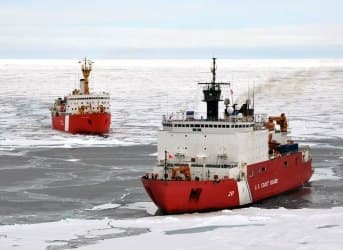Russia’s state-owned oil firm Rosneft is to build two shipyard facilities to construct vessels and platforms for its push to exploit Russia’s Arctic regions, according to Deputy Prime Minister Dmitri Rogozin.
One facility will be a new shipyard complex in Rosliakovo in Russia’s northern Murmansk region, a “dual use” facility for both military and civilian shipbuilding. Rosneft will also create a consortium that would produce liquefied natural gas carriers and Arctic drilling platforms. Production will take place at the Zvezda shipyard in the far eastern Primorie region starting next year. Rosneft currently has no offshore drilling platform in the Arctic. Gazprom operates the Prirazlomnaia oil rig, made at Sevmash shipyard in the Arkhangelsk Region, utilizing the top half of a scrapped Norwegian platform. Prirazlomnaia gained notoriety last autumn when a bunch of Greenpeace activists clambered aboard, only to be promptly arrested by Russian authorities, who initially charged them with “piracy,” subsequently downgraded to “hooliganism” but who were eventually pardoned by President Putin in the run-up to the Sochi Winter Olympics.
The Rosneft investment is part of a larger Russian government plan to develop its Arctic regions’ reserves of oil and natural gas. Last October Regional Development Minister Igor Slyuniaev stated that the government intended to spend 2 trillion rubles ($63 billion) by 2020 in a strategic program to develop the Arctic, with the government expecting that more than half the costs will be covered by major Russian companies. Arctic territories hold huge untapped natural resources and in recent years have been the subject of conflicting claims from Canada, Denmark, Norway, Russia and the United States. Global warming’s rising temperatures have caused a reduction in sea ice, allowing easier access to lucrative offshore oil and gas deposits.
Related article: Russian Lukoil to Double Overseas Output with Iraq
On 29 August 2011 Exxon Mobil signed an Arctic oil exploration deal with Rosneft in the presence of Russian Prime Minister Vladimir Putin. Proving that the Cold War is well and truly dead, at least for multinationals, Putin gushed, "New horizons are opening up. One of the world's leading companies, Exxon Mobil, is starting to work on Russia's strategic shelf and deepwater continental shelf. The potential oil fields are some of the largest in circumpolar Arctic offshore area.” The contract stipulates that Exxon Mobil and Rosneft will jointly spend $3.2 billion on deepwater exploration in the Russian Federation’s East Prinovozemelskii region of the Kara Sea.
Two years later Rosneft and ExxonMobil signed additional agreements for joint research and development in the Arctic of new technologies, including plans for the two companies to establish a joint “Arctic Research Center” (ARC) in Russia and a broad technology-sharing accord. ExxonMobil said in a statement, “The ARC will provide Rosneft and ExxonMobil joint ventures a full range of research, development and technical services, with near-term focus on the Kara Sea.” Rosneft CEO Igor Sechin said, “The ARC will be a platform for development of the most up-to-date and efficient technologies aimed at project implementation in complex and challenging climate and technological conditions.”
Greenpeace and other environmentalist groups are obviously going to have their hands full in the future as these plans move forward. The Russian environmental Group Bellona issued a report about the 16 March 2009 incident where the nuclear-powered icebreaker Yamal collided with the 16.168 ton tanker Indiga during ice escort duty in the Kara Sea, which was shuttling between the oil terminal in the Gulf of Ob and the floating oil storage vessel Belokamenka in the Kola Bay. The Indiga suffered a 31foot-long crack on its main deck from the impact of the collision, but fortunately the tanker was only carrying ballast at the time.
But as the development of Russia’s Arctic hydrocarbon reserves is a government priority, the only certainty is that such incidents will continue in the harsh Arctic environment.
By. John C.K. Daly


















